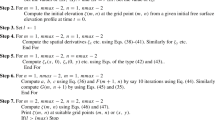Abstract
Free surface flow of an incompressible fluid over a shallow plane/undulating horizontal bed is characteristically turbulent due to disturbances generated by the bed resistance and other causes. The governing equations of such flows in one dimension, for finite amplitude of surface elevation over the bed, are the Continuity Equation and a highly nonlinear Momentum Equation of order three. The method developed in this paper introduces the “discharge” variable q = η U, where η = elevation of the free surface above the bed level, and U = average stream-wise forward velocity. By this substitution, the continuity equation becomes a linear first-order PDE and the momentum equation is transformed after introduction of a small approximation in the fifth term. Next, it is shown by an invertibility argument that q can be a function of η: q = F(η), rendering the momentum equation as a first order, second degree ODE for F(η), that can be be integrated by the Runge-Kutta method. The continuity equation then takes the form of a first order evolutionary PDE that can be integrated by a Lax-Wendroff type of scheme for the temporal evolution of the surface elevation η. The method is implemented for two particular cases: when the initial elevation is triangular with vertical angle of 120 ∘ and when it has a sinusoidal form. The computations exhibit the physically interesting feature that the frontal portion of the propagating wave undergoes a sharp jump followed by tumbling over as a breaker. Compared to other discretization methods, the application of the Runge-Kutta and an extended version of the Lax-Wendroff scheme is much easier.
Similar content being viewed by others
References
Abbott, H.B.: Computational Hydraulics: Elements of the Theory of Free Surface Flows. Pitman, London (1979)
Benqué, J.P., Cunge, J.A., Feuillet, J., Hauguel, A., Holley, Jr. F.M.: New method for tidal current computation. J. Water Port Coast Ocean Div. ASCE 108, 396–417 (1982)
Bonneton, P., Chazel, F., Lannes, D., Marche, F., Tissier, M.: A splitting approach for the fully nonlinear and weakly dispersive Green-Naghdi model, vol. 230 (2011)
Bose, S.K., Dey, S.: Curvilinea flow profiles based on Reynolds averaging. J. Hydraul. Engg. 133, 1074–1079 (2007)
Bose, S.K., Dey, S.: Reynolds averaged theory of turbulent shear flows over undulating beds and formation of sand waves. Phys. Rev. E 80, 036304–1-9 (2009)
Bose, S.K.: Shallow water turbulent surface wave striking adverse slope. Acta Geopys. 63, 1092–1102 (2015)
Bose, S.K.: Some solutions of simplified open channel flow equations. Int. J. Fluid Mech. Res. 43, 95–104 (2016)
Bose, S.K.: Numeric Programming in Fortran. Narosa, New Delhi (2009)
Casulli, V., Cheng, R.T.: Semi-implicit finite difference methods for three- dimensional shallow water flow. Int. J. Num. Meth. Fluids 15, 629–648 (1992)
Casulli, V., Stelling, G.S.: Numerical simulation of 3D quasi-hydrostatic, free surface ows. J. Hydaul. Eng. 124, 678–686 (1998)
Chen, X.J.: A free-surface correction method for simulating shallow water flows. J. Comput. Phys. 189, 557–578 (2003)
Chen, C., Beardsley, R., Cowles, G.: An unstrucured grid, finite volume coastal ocean model (FVCOM) system. Oceaography 19, 78–89 (2006)
Chow, V.T.: Open Channel Hydraulics. McGraw-Hill, New York (1959)
Cunge, J.A., Holly, F.M., Verwey, A.: Practical Aspects of Computational River Hydraulics. Pitman, London (1980)
Dawson, C., Kubatko, E.J., Westerink, J.J., Trahan, C., Mirabito, C., Michoski, C., Panda, N.: Discontinuous Galerkin methods for modeling hurricane storm surge. Adv. Water Resour. 34, 1165–1176 (2011)
Fennema, R.J., Chaudhry, M.H.: Explicit methods for 2-D transient free surface ows. J. Hydraul. Eng. 116, 610–614 (1990)
Garcia-Navarro, P., Alcrudo, F., Savirón, J.M.: 1-D open-channel ow simula tion using TVD-McCormack scheme. J. Hydraul. Eng. 118, 79–93 (1992)
Garcia-Navarro, P., Hubbard, M.E., Priestley, A.: Accurate flux vector splitting for shocks and shear layers. J. Comput. Phys. 121, 79–93 (1995)
Gunawan, P.H., Eymard, R., Pudjaprasetya, S.R.: Staggered scheme for the Exner-shallow water equations. Comput. Geosci. 19, 1197–1206 (2015)
Katopodes, N.D.: A dissipative Galerkin scheme for open-channel flow. J. Hydraul. Eng. 110, 450–466 (1984)
Longuet-Higgins, M.S.: On the overturning of gravity waves. Proc. Roy. Soc. London, Ser. A 376, 377–400 (1981)
Luettich, R.A., Westerink, J.J., Sceffner, N.W.: ADCIRC : An advanced three-dimensional circulation model for shelves, coasts, and estuaries; Report 1. Theory and Methodology of ADCIRC - 2DDI and ADCIRC - 3DL. No, CERC - TR - DRP -92 -6. Coastal Engineering Research Center, Vicksberg MS
Mader, C.L.: Numerical Modeling of Water Waves. CRC Press, Boca Raton (2004)
Namin, M.M., Lin, B., Falconer, R.A.: An implicit numerical algorithm for solving non-hydrstatic free-surface flow problems. Int. J. Num. Meth. Fluids 35, 341–356 (2001)
Panda, N., Dawson, C., Zhang, Y., Kennedy, A.B., Westerink, J.J., Donahue, A.S.: Discontinuous Galerkin methods for solving Boussinesq-Green-Naghdi equations in resolving non-linear and dispersive surface water waves. J. Comput. Phys. 273, 572–588 (2024)
Perlin, M., Choi, W., Tian, Z.: Breaking waves in deep and intermediate waters. Annu. Rev. Fluid Mech. 45, 115–145 (2013)
Quecedo, M., Pastor, M.: Finite element modelling of free surface ows on inclined and curved beds. J. Comput. Phys. 189, 45–62 (2003)
Sclichting, H., Gersten, K.: Boundary Layer Theory. Springer, Berlin (2000)
Stoker, J.J.: Water Waves. Interscience, New York (1957)
Stokes, G.G.: Supplement to a paper on the theory of oscillatory waves. Mathematical and Physical Papers, 1, 314-326, Camb. Univ. Press (1880)
Xing, Y., Shu, C.-W.: High order finite difference WENO schemes with exact conservation property for the shallow water equations. J. Comput. Phys. 208, 206–227 (2005)
Zhang, Y.-L., Baptista, A.M.: A semi-implicit Eulerian-Lagrangian finite-element model for cross-scale ocean circulation. Ocean Model. 21, 71–96 (2008)
Zhang, Y., Kennedy, A.B., Panda, N., Dawson, C., Westerink, J.J.: Boussinesque-Green-Naghdi rotational water eave theory. Coast. Eng. 73, 13–27 (2013)
Author information
Authors and Affiliations
Corresponding author
Rights and permissions
About this article
Cite this article
Bose, S.K. A numerical method for the solution of the nonlinear turbulent one-dimensional free surface flow equations. Comput Geosci 22, 81–86 (2018). https://doi.org/10.1007/s10596-017-9671-y
Received:
Accepted:
Published:
Issue Date:
DOI: https://doi.org/10.1007/s10596-017-9671-y




